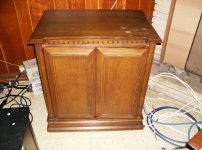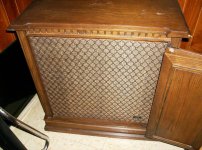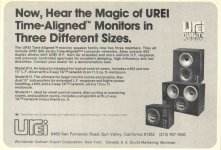Thank you for that Ron.
I did not get mine measured yet, still working on it.
I was playing around with a vented box calculator at mh-audio last night, but it seemed to recommend a fairly small box for my drivers, based on the published T/S parameters. I was probably doing something wrong though.
I did not get mine measured yet, still working on it.
I was playing around with a vented box calculator at mh-audio last night, but it seemed to recommend a fairly small box for my drivers, based on the published T/S parameters. I was probably doing something wrong though.
Many Altecs were L-Pads but wired as a pot.I'm assuming it's a rheostat type of pot with a wound wire track.
OK you lost me.
Are you saying... hmm, see I thought a rheostat and potentiometer were electrically the same thing, differing primarily in the robust construction of most rheostats, as they are typically used where heat and adjustment of large signals are present and required?
I assumed an "L pad" was a different implementation of a level control that maintains impedance? (Which could theoretically be assembled using fixed resistors, rheostat or potentiometer.)
I'm sorry Cal I am genuinely confused by this.
Are you saying... hmm, see I thought a rheostat and potentiometer were electrically the same thing, differing primarily in the robust construction of most rheostats, as they are typically used where heat and adjustment of large signals are present and required?
I assumed an "L pad" was a different implementation of a level control that maintains impedance? (Which could theoretically be assembled using fixed resistors, rheostat or potentiometer.)
I'm sorry Cal I am genuinely confused by this.
I will measure the 6BQ5 amp, what frequency would be most relevant? say 30 or 60 Hz?
Are you saying the big box is still going to shout, or are you referring to my current small boxes?
Good question, way back when it was usually specified and if not, we calculated it from component specs since we didn’t have elaborate test gear. Regardless, I found this, though instead of 1 kHz I’m thinking a few hundred Hz since we’re interested in the woofer’s flat pass-band: Measuring input impedance and calculating output impedance calculation calculate audio amplifier op-amp voltage gain total loudspeaker speaker microphone resistance resistor bridging matching test load loudspeaker source resistance - Why input impeda
Of course it will ‘shout’ if the horn is run ‘hot’, i.e. at a higher efficiency than the woofer. The big box only lowers the point where the bass begins rolling off. You would need a [mid] bass horn otherwise to increase its efficiency and even then the HF would still be a little ‘hotter’ if not attenuated some since it’s so efficient.
GM
Good question, way back when it was usually specified and if not, we calculated it from component specs since we didn’t have elaborate test gear. Regardless, I found this, though instead of 1 kHz I’m thinking a few hundred Hz since we’re interested in the woofer’s flat pass-band: Measuring input impedance and calculating output impedance calculation calculate audio amplifier op-amp voltage gain total loudspeaker speaker microphone resistance resistor bridging matching test load loudspeaker source resistance - Why input impeda
GM
Thanks for yet another good link.
Of course it will ‘shout’ if the horn is run ‘hot’, i.e. at a higher efficiency than the woofer. The big box only lowers the point where the bass begins rolling off. You would need a [mid] bass horn otherwise to increase its efficiency and even then the HF would still be a little ‘hotter’ if not attenuated some since it’s so efficient.
GM
OK I am on the same page now.
I just finished cleaning the pots with acetone in the crossovers.
If I didn't know any better I would say the speakers might even sound a little better.
I will look for some replacements or perhaps hard wire in some resistors. No biggy.
Just to clarify I have been calling my cabinets Valencia, more accurately they are a "Flamenco" cabinet which typically housed a separate woofer and horn.
Speakers often do sound better after the pots are cleaned, though I recommend using something with a lubricant, otherwise the pots can arc their way to permanently noisy. Here’s some good info: Antique Radio Forums • View topic - Cleaning Potentiometers
What to clean potentiometers with? - The Gear Page
Regardless, using a pot to dial in the speaker, then replacing it with a resistor bank is the way to go long term.
I ‘hated’ the style, but the late ‘60s-early ‘70s home style was Mediterranean and butcher block, so surprised Altec didn’t offer the latter also:
http://www.lansingheritage.org/images/altec/catalogs/1971-home/page14.jpg
GM
Speakers often do sound better after the pots are cleaned, though I recommend using something with a lubricant, otherwise the pots can arc their way to permanently noisy. Here’s some good info: Antique Radio Forums • View topic - Cleaning Potentiometers
What to clean potentiometers with? - The Gear Page
Regardless, using a pot to dial in the speaker, then replacing it with a resistor bank is the way to go long term.
GM
I agree they should be lubed and I should get something for this as I always find myself without anything on hand. I debated digging out some lithium from the garage, but figured it wasn't worth the effort until I get something proper or a replacement.
I ‘hated’ the style, but the late ‘60s-early ‘70s home style was Mediterranean and butcher block, so surprised Altec didn’t offer the latter also:
http://www.lansingheritage.org/images/altec/catalogs/1971-home/page14.jpg
GM
Yes it is the set pictured in the middle.
So these center consoles were sold empty? This would explain me thinking what I purchase was modified unit, as the cutouts were amateurish.
Actually I don't mind the look of the set on the bottom of the page.
No, you have it right.OK you lost me.
When you use only 2 of the 3 terminals of an L-Pad, it becomes a simple pot. For whatever reason, Altec chose to do this in a number of their speakers.I'm sorry Cal I am genuinely confused by this.
I measured some 604C's a couple years ago
Fs 41.4
Qts 0.173
Qes 0.183
Vas 11.1 cubic feet
Re 8.1 ohms
Fs 40.9
Qts 0.168
Qes 0.180
Vas 11.6 cubic feet
Re 8.1 ohm
Ouch... That is quite low Qts. What kind of bass can you expect from that ?
If this is the case i would not use them below 100Hz or so. Few dedicated subs would do the trick for adding sufficient amount of bass.
Last edited:
So these center consoles were sold empty?
Actually I don't mind the look of the set on the bottom of the page.
Don’t know, the only one of these cabs I saw was pre-cut for Altec branded components, which happened to being installed by the distributor while I was there, so either it was modified later and/or it could be ordered with a blank panel as Altec was always very flexible about accepting custom orders that weren’t listed as factory options. Maybe Todd or one of the others on the AUF will know.
Agreed, though its ‘floppy’ bi-fold doors didn't encourage 'spirited' music:
GM
Attachments
I measured some 604C's a couple years ago
Thanks! Can’t have too many measured specs for reference. Do you know if they have been re-coned and by any chance have the OEM build date codes [391xxx] normally stamped on the frame?
Like all Altecs I’m aware of, measured specs of drivers after ~1957 are ‘all over the map’ thanks to the rapidly changing electronics and them moving towards fewer re-cone kit options to cut costs after Ling bought and began gutting them.
Spec wise, these are quite rare compared to the others I have, which typically are in the ~ 50-55 Hz, 0.21-0.27 Qts, 137-194 L Vas range.
GM
Ouch... That is quite low Qts. What kind of bass can you expect from that ?
Same as when it came out, it was common for amps to either be high output impedance and/or have variable DF tone controls that could flatten these out to nominally flat in room down to at least the lowest notes on recordings of the day or around 45-50 Hz when tuned to Fs.
Today, one would use a combination of EQ and [acoustically large] cab alignment to get it flat down low enough for most recorded music and/or to easily XO it to a separate sub system.
GM
Do you know if they have been re-coned and by any chance have the OEM build date codes [391xxx] normally stamped on the frame?
Don't have the codes. The guy got them off craigslist from an older gent. They were in vented cabinets that were rather elaborate furniture and roughly 6-10 cubic feet with the original altec xo. There was a sort of felt material transition to the cone behind the multicell horn and they were believed to be original.
No experiences on cabinets that big, I guess it'd probably be very similar to IB once the volume go beyond a point. (I remember I've played some numbers in hornresp for this... )
And, for the driver itself, working (load) condition on IB or OB is almost the same. (it's different in surrounding air) So, I might say, huge cabinet has the benefit very similar to OB, but no dipole loss. How nice!
As to the old fashion of low driver Q and high impedance amp, I think it's working wonderfully. I myself use it on OB and I consider the combination is a success.
IB or big cabinet must be much better !
And, for the driver itself, working (load) condition on IB or OB is almost the same. (it's different in surrounding air) So, I might say, huge cabinet has the benefit very similar to OB, but no dipole loss. How nice!
As to the old fashion of low driver Q and high impedance amp, I think it's working wonderfully. I myself use it on OB and I consider the combination is a success.
IB or big cabinet must be much better !
For LF with style maybe something à la UREI... 
Ouch... That is quite low Qts. What kind of bass can you expect from that ?
If this is the case i would not use them below 100Hz or so. Few dedicated subs would do the trick for adding sufficient amount of bass.
Attachments
For LF with style maybe something à la UREI...
Now that looks like a loudspeaker with sufficient amount of bass
Last edited:
I finally have a result as far as T/S parameters. I apologize for my delay.
One speaker has a Fs of 31Hz, the other has a Fs of just under 31Hz.
I have been trying to wait for silence or setup somewhere quiet, but I just wanted to get a move on it this long weekend.
I used the instructions put together by DIYaudio member richie00boy found here: Read Research - Communication Cheers.
I have completed up to step 4.3.2 (Fs).
Just thought I would ask if I need to find out anything else while I have them on the bench, or can I use this Fs in conjunction with previously published specs?
One speaker has a Fs of 31Hz, the other has a Fs of just under 31Hz.
I have been trying to wait for silence or setup somewhere quiet, but I just wanted to get a move on it this long weekend.
I used the instructions put together by DIYaudio member richie00boy found here: Read Research - Communication Cheers.
I have completed up to step 4.3.2 (Fs).
Just thought I would ask if I need to find out anything else while I have them on the bench, or can I use this Fs in conjunction with previously published specs?
- Status
- This old topic is closed. If you want to reopen this topic, contact a moderator using the "Report Post" button.
- Home
- Loudspeakers
- Multi-Way
- Fun with 604E


